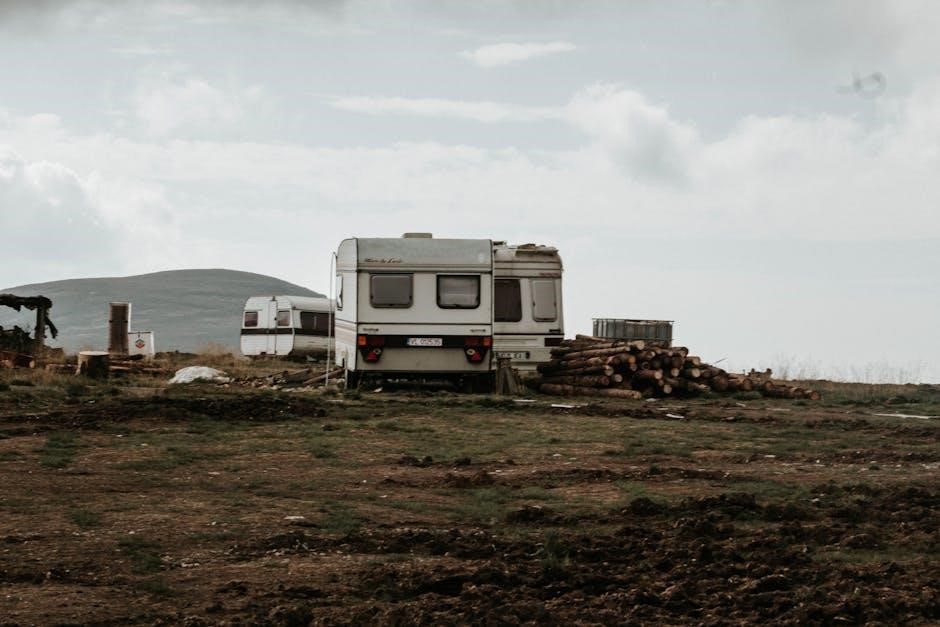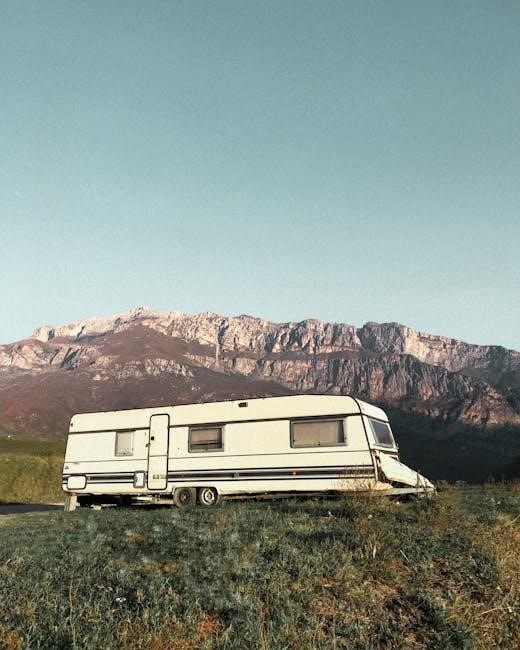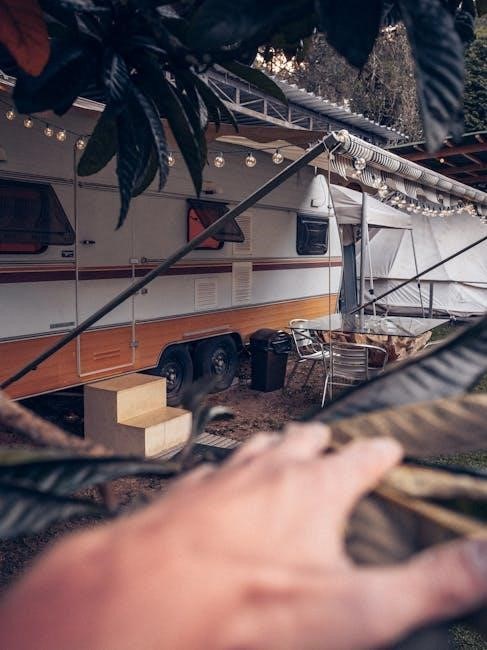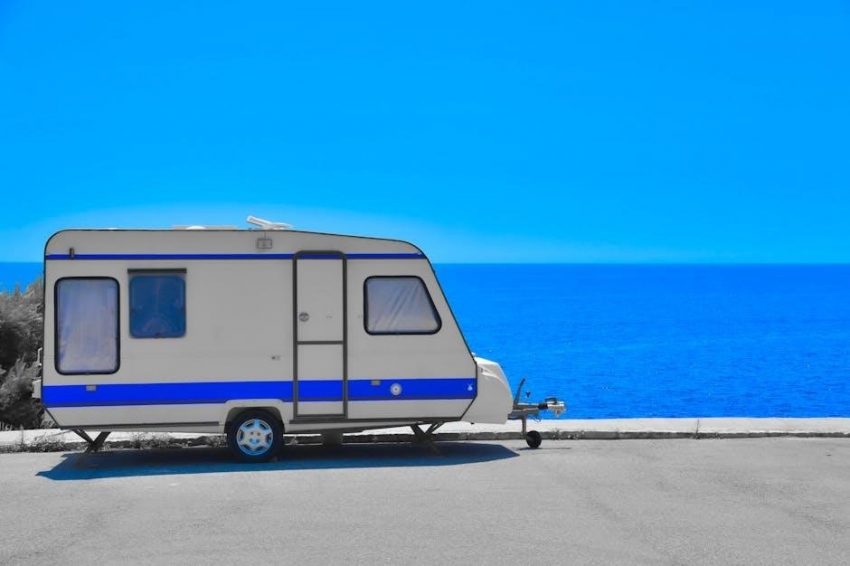Camper trailer wiring is essential for safe and functional connections between your vehicle and trailer. It ensures proper lighting, braking, and electrical systems operation, enhancing towing safety and efficiency.
Understanding the Basics of Camper Trailer Wiring

Camper trailer wiring involves connecting electrical systems between a tow vehicle and a trailer to ensure proper lighting, braking, and power supply. It typically uses a harness with connectors like 4-pin or 7-way plugs, each serving specific functions such as tail lights, brake lights, and auxiliary power. The wiring system must be correctly matched to the trailer’s electrical needs to avoid malfunctions. Color-coded wires simplify identification: brown for tail lights, red for brakes, and yellow for turn signals. A Y-harness is often used to connect multiple lights. Understanding the wiring diagram is crucial for safe and efficient setup. Always test connections to ensure reliability and prevent electrical issues during towing.
Importance of Proper Wiring for Safety and Functionality
Proper camper trailer wiring is critical for both safety and functionality. It ensures that all lights, brakes, and electrical systems operate correctly, reducing the risk of accidents. Correct wiring connects the tow vehicle and trailer seamlessly, enabling communication between systems. Improper connections can lead to faulty brake lights or turn signals, posing a hazard on the road. Additionally, proper wiring prevents electrical overloads and short circuits, which can damage equipment or cause fires. Regular inspections and maintenance are essential to uphold reliability. By adhering to wiring standards and using the right connectors, you ensure a safe and efficient towing experience. Proper wiring is not just a technical requirement but a vital safety measure for any camper trailer setup.
Types of Trailer Wiring Connectors
Trailer wiring connectors vary, with common types including 4-pin, 5-way, 6-way, and 7-way RV blade connectors. Each serves specific purposes, ensuring compatibility and functionality for different trailer needs.
4-Pin Trailer Wiring Diagram and Applications
The 4-pin trailer wiring connector is a common setup for light-duty trailers, offering a straightforward connection for basic functions. It typically includes a ground wire, tail lights, brake lights, and turn signals. This configuration is ideal for utility trailers, boat trailers, and smaller campers that require essential lighting. The wiring diagram is color-coded, with brown for tail lights, red for brake lights, green or yellow for turn signals, and white for the ground. This system ensures simplicity and reliability, making it a popular choice for trailers with minimal electrical requirements. It’s widely used due to its ease of installation and compatibility with most vehicles, providing a safe and efficient connection for towing needs.

7-Way RV Blade Trailer Wiring Explained
The 7-way RV blade trailer wiring is a comprehensive connector designed for heavy-duty applications, offering advanced functionality for larger trailers and RVs. It includes seven pins, each serving a specific purpose: two for brake controls, one for a battery charge, one for an auxiliary power supply, and three for lighting functions. This connector supports electric brakes, providing enhanced safety and control. It also powers auxiliary systems like interior lights and refrigerators. The 7-way blade is widely used in RVs and campers due to its versatility and reliability. Proper installation ensures seamless communication between the tow vehicle and trailer, supporting all necessary electrical functions for safe and efficient towing experiences. This system is a must for modern RV setups requiring multiple power connections.
5-Way and 6-Way Trailer Connector Color Codes
The 5-Way and 6-Way trailer connectors use standardized color codes to ensure proper wiring connections. For the 5-Way connector, the colors are typically as follows: green for the right turn signal, yellow for the left turn signal, brown for taillights and marker lights, red for brake lights, and white for the ground connection. The 6-Way connector adds an additional blue wire, often used for auxiliary power, such as electric brakes or other systems. These color codes help in identifying each wire’s function, making the wiring process more straightforward; It’s advisable to consult a specific wiring diagram for your vehicle or trailer to confirm these standards, as variations can occur. Understanding these codes is crucial for ensuring safe and functional electrical connections for your camper trailer.

Camper Trailer Wiring Components
Key components include the Y-harness for connecting multiple lights and the RV 7-pin connector for advanced functions. These components ensure reliable electrical connections for your camper trailer.
Y-Harness: Connecting Multiple Trailer Lights
The Y-harness is a crucial component for camper trailers, allowing connection of multiple lights to a single wiring system. It simplifies the process of linking brake lights, turn signals, and running lights, ensuring all functions operate seamlessly. By distributing power evenly, the Y-harness prevents electrical overload and enhances safety. This setup is especially beneficial for trailers with numerous lights, providing a clean and organized wiring configuration. Proper installation of the Y-harness ensures reliable performance, reducing the risk of electrical faults and ensuring compliance with safety standards. Always consult a wiring diagram for accurate connections to maintain functionality and avoid potential hazards.
RV 7 Pin Trailer Wiring Diagram and Installation
The RV 7-pin trailer wiring diagram is a comprehensive guide for connecting electrical systems between a tow vehicle and a camper trailer. It includes seven pins, each serving a specific function: power, ground, left turn, right turn, brake, auxiliary, and backup lights. Proper installation ensures all trailer lights and amenities operate correctly. Begin by connecting the wiring harness to the vehicle’s electrical system, matching each pin to its designated function. Use a wiring diagram to avoid confusion and ensure safety. Test each connection to verify functionality before towing. Regularly inspect the wiring for damage or corrosion to maintain reliability and prevent electrical failures during travel. Always follow safety guidelines and consult a professional if unsure.

Trailer Plug Wiring Guide

A trailer plug wiring guide helps connect your vehicle to the camper trailer safely. It includes diagrams for 4-pin, 5-way, and 7-way connectors, ensuring proper light and brake functions.
Step-by-Step Instructions for Wiring a Trailer Plug
Wiring a trailer plug requires careful planning and attention to detail. Start by gathering your tools and consulting a wiring diagram specific to your connector type. Begin by connecting the ground wire to the vehicle’s frame, ensuring a secure attachment. Next, identify the function of each wire (e.g., taillights, brakes, turn signals) and connect them to the corresponding pins on the plug. Use a wiring harness if available to simplify the process. Test each light and brake function to ensure proper connectivity. Finally, secure all wires with electrical tape or heat shrink tubing to protect against wear and tear. Always double-check your work for safety and reliability.
Understanding Trailer Plug and Socket Types
Trailer plugs and sockets come in various configurations to suit different towing needs. The 4-pin flat connector is common for basic setups, powering taillights and brakes. For more complex systems, 5-way, 6-way, and 7-way connectors are used, offering additional functions like auxiliary power and electric brakes. The 7-way RV blade connector is popular for campers, providing seven individual connections. It’s crucial to match the plug type with the socket to ensure compatibility and proper functionality. Always refer to your vehicle and trailer manuals to determine the correct connector type. Using the wrong configuration can lead to electrical issues or safety hazards, so careful selection is essential for reliable towing.

Troubleshooting Common Wiring Issues
Identifying and resolving wiring faults ensures camper trailer safety and functionality. Common issues include faulty connectors, blown fuses, and damaged wires, which can disrupt lighting and braking systems.
Diagnosing and Repairing Faulty Trailer Lights
Diagnosing faulty trailer lights involves checking connections, fuses, and bulbs. Start by ensuring all plugs and sockets are clean and securely connected. If a light isn’t working, test the bulb and replace it if necessary. For more complex issues, refer to your wiring diagram to trace circuits. Use a multimeter to check for power at the connector pins. If no power is detected, inspect the wiring for damage or corrosion. Repair or replace damaged wires, and ensure all connections are tight. Properly functioning trailer lights are crucial for safety, so thorough diagnosis and prompt repairs are essential.
Resolving Connector and Wiring Faults
Resolving connector and wiring faults requires a systematic approach. Begin by inspecting connectors for dirt, corrosion, or damage. Clean or replace faulty connectors to ensure proper electrical flow. Next, examine the wiring for signs of wear, cuts, or fraying. Use a multimeter to test for continuity and identify any breaks in the circuit. If a wire is damaged, splice in a new section or replace it entirely. Apply dielectric grease to connectors to prevent corrosion. Regular maintenance can prevent issues, but when problems arise, addressing them promptly ensures reliable performance and safety while towing. Always refer to your camper trailer wiring guide for specific instructions.
Safety Tips and Best Practices
Always ensure secure electrical connections to prevent sparks and fires. Regularly inspect wiring for damage and corrosion. Use proper tools and follow diagrams to avoid errors.
Ensuring Safe Electrical Connections for Your Camper Trailer
Safety begins with secure connections to prevent power surges or short circuits. Always use high-quality cables and connectors designed for outdoor use. Regular inspections are crucial to identify frayed wires or corroded terminals.
